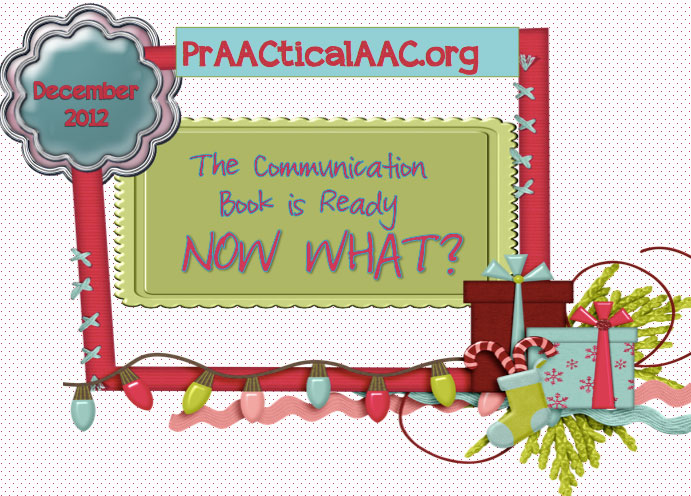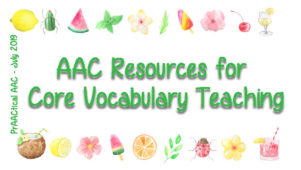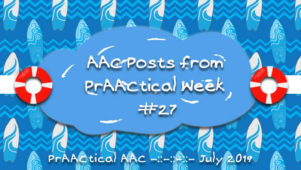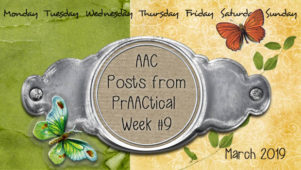The Communication Book is Ready… Now What?

The Communication Book is Ready… Now What?
The fun begins…. Yes, we really do think that TEACHING a learner to USE the communication book is FUN. We get to participate in lots of meaningful language experiences, we get to be creative, we get to watch language blossom, and we get to be surprised by the communication competence ALL of our learners show us after prAACtice, prAACtice, and for some more prAACtice .
The best way to get started with communication book teaching is to begin by trying out different teaching tips, strategies, and resources and find out what works best. Each communication dyad (communicator & communication partner) is different so the combination of strategies that will work will vary but at the core of the teaching process, there should be fun, motivation, and of course progress.
STRATEGIES and CONSIDERATIONS
Aided Language Input (ALI)– We can not say enough about the power of ALI. ALI is the strategy of modeling language by pointing to key words/symbols on the AAC system as you speak (in this case, the communication book). We are asking our learners to communicate through their communication book. If they never see it modeled how will they know how to use it.
- Why We Love Aided Language Input
- Aided Language Input- Strategy of the Month
- Learning to Use Aided Language Input
- Aided Language Input Demo (Video of the Week)
- Curated Resources on AIded Language Input
Opportunities for Active Participation- Active participation is the concept that the learner needs to do more than listening. They need to have opportunities to initiate and respond to communication. They need to have specific opportunities to ask questions, answer questions, ask for things, refuse things, explain, vent, and even argue. We have many parents who tell us their children will have a ‘visual language’ argument with them… and then we know…. the teaching process has been successful. Specific opportunities can also be called ‘communication temptations’. Communication temptations are structured situations designed to ‘entice’ communication without asking a question. They help a learner to become an initiator. It is fairly easy to entice a request (put a favorite toy or food in a sealed plastic jar), but it is just as important to entice other communication functions as well.
- How to Make Communication Temptations Really Work!
- Go Ape 10 Commenting Communication Temptations
- 5 Apps for Tempting Commenting and Other Language
- Building Communication Opportunities
Meaningful Feedback: Language Expansions & Specific Reinforcement- We need to provide specific and meaningful feedback when the learner makes attempts at using the communication book. This is definitely positive reinforcement but goes way beyond the ‘good job’ that we often hear again and again. Reinforcement is about more than increasing self-esteem. It is about learning more and going to the next level. To do this, feedback should first involve honoring the communication intent and providing a language expansion. The positive reinforcement is honoring the communication intent (giving the toy, moving out of the way, stopping an undesired action- no need to say “good job”). At the same time, provide a communication book language expansion. The expansion is the AAC modeling of a more complex language concept. It would look like this: Learner- says “ball” using the communication book, Facilitator uses aided language input to say “more ball” or “big ball” or any other expanded version of the initial communication. A general rule of thumb is if the learner uses 1 word spontaneously, provide an expansion of 2 words, if the learner uses 2 words spontaneously, provide an expansion of 3 words, and so on… There are times we also need to provide specific reinforcement for a skill or process. Depending upon the goal, we may want to be specific about remembering to take the communication book ‘ALL by THEMSELVES’, or ‘for SCANNING a FEW Pages’. We try and make the communication and reinforcement as natural as possible, but the combination of language expansions and specific reinforcement will help facilitate learning.
Other Language Facilitation Strategies- Teaching communication and language with a communication book is not much different then teaching communication & language in general. So consider adding scaffolding and recasting into your teaching tool kit (we tend to do this naturally, just add the AAC support).
Goals Should be Meaningful- Check out more than 95 potential goals in PrAActical Goals That Matter (and the editable document included within this post). Add any you think are great. With all of the goals, once you have decided, think about repetition with variety. If you are teaching asking “what” questions, you may begin by asking “what’s in the box”, but then can practice hiding toys in plastic easter eggs and asking “what’s in the egg” or “what’s in the bag” (after holiday shopping). The repetitions are endless, just make them real and meaningful (we only ask questions when we do not know the answer).
SHINING EXAMPLES (just a few, thank you so much!)
And a few from our archives (Getting from Here to There):
- “I know you said to try and honor the symbolic request with the picture symbol but how many times a day do I have to go to McDonalds”? [They had been there 5 times that day!!]
- “I taught him to use adjectives in a full sentence so quickly-Amazing! I put him in the car, turned on the heater, and modeled one time- ‘make the car cooler’ and he got it! [Brave Mama to do this in the midst of a Florida summer!]
- “Even though she just started elementary school, I knew middle school would come so fast. That’s why I set up lockers instead of bins in the playroom and taught the words on her system to go with the whole middle school locker experience.” [Wish I would have thought of that!]
- “Thanks so much for letting him continue at therapy. He has been kicked out of so many places, but by giving him the opportunity to use communication supports to say ’I want to play alone’, he now doesn’t most of the time and he can communicate so many things.”
- “I didn’t realize the ‘Wendy’s’ symbol was gone from his system. He kept telling me ‘windy’ from his weather page. I tried to really listen from his point of view and then I realized we just passed Wendy’s. It hit me how sophisticated his communication is becoming.” [You and me, both!]
- “He stands by this bag with his toileting items at school to let them know he has to go to the bathroom. Can that be one of his object communication symbols?” [Great idea, Mom! By the way, can you come guest lecture in my class tonight?]
- “You remember my husband, the one who thought this AAC stuff was not really going to work? Well, he’s been watching our son in communication therapy and now he’s pestering me when I forget to bring his AAC device/supports to the dinner table.”
–
Filed under: Strategy of the Month
Tagged With: COmmunication Books, resources, tips
This post was written by Robin Parker







